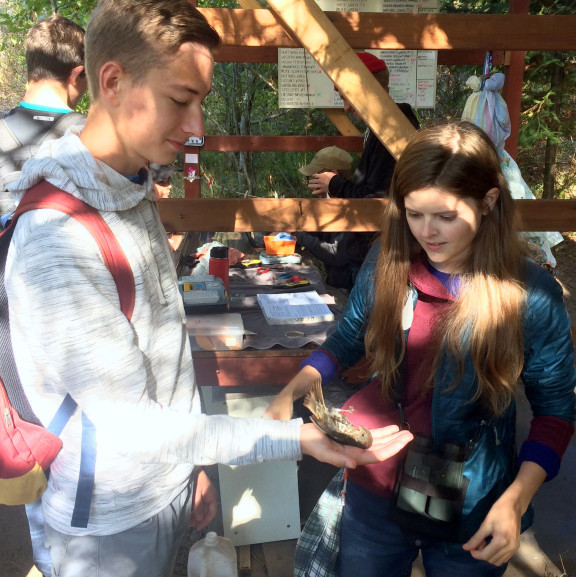50p

Bird Banding in Bio 11
On a bright and sunny Saturday morning in September, Mr. Miller’s Biology 11 classes departed for Rocky Point Bird Observatory (RPBO) on southern Vancouver Island to enjoy a morning of birding and bird banding. The RPBO sits on a migratory pathway for many songbirds, birds of prey, and seabirds as they make their way off Vancouver Island and on through Washington state to sunnier climes in the fall.
Bird banding involves placing an alpha-numeric band on the leg of a bird, akin to wearing a wristwatch for you and me. When a bird is recaptured or recovered, the band helps scientists to track migratory routes and estimate number of birds during their annual migratory movements. A chance to visit an active banding station was a great opportunity for Brentwood students.
Joining the group was Residence Faculty Assistant Ms Hampshire – a veteran bird-bander with many years of banding experience. We arrived on site and the students were dispatched to one of three activities: a bird hike with RPBO staff; a table with various birds and related specimens; or the bird-banding station itself.
On the hike, students were shown how to correctly identify common species from both sight and sound. Using binoculars, students had the opportunity to identify anywhere from 13-15 species that were present on-site. One group also observed a river otter in the nearby estuary of Pedder Bay. Many migrating turkey vultures also made their way onto the scene and provided a glimpse of the annual southern movements of some birds of prey resident to Vancouver Island.
The specimen table gave students the chance to examine specimens and replicas of both eggs and nests of some of the common bird species found on Vancouver Island. Students could examine the wings of owls and could easily observe the remarkable adaptations of these birds to silent, stealthy flight. Examples of skulls and legs also provided clues to differences in food habits of many species.
The banding station was, by far, the highlight for students. With the help of RPBO volunteers and Ms Hampshire, our classes were able to observe close-hand, the banding process and collection of data from at least 10 songbird species. After bands were placed and measurements taken, students were given the opportunity to release processed birds. Seeing birds up close and in the hand, students could make connections to the process of natural selection – a process that could shape the bills of many species into diet-specific machines. We also viewed the array of nets that were used to temporarily capture birds. The information gathered through projects such as the RPBO has proven invaluable to the monitoring efforts by biologists of many species of North America birds.
It was a great experience for all. I imagine this was the first time students have observed tweets from the originators of the tweet itself. ;-)
Mr. Miller